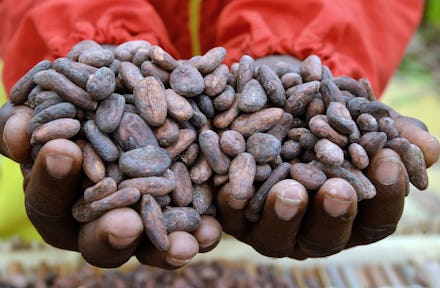Your Halloween Candy Probably Comes From Child Slave Labor

Your favorite treat may just be a trick.
Hershey, Mars (M&M's, Snickers) and Nestle, responsible for some of our favorite Halloween treats, are the defendants in three separate, ongoing California lawsuits. The federal class-action suits claim the candy companies use cocoa derived from child slave labor and have deceived California's candy-buying public by presenting themselves as socially and ethically responsible.
"America's largest and most profitable food conglomerates should not tolerate child labor, much less child slave labor, anywhere in their supply chains," the complaints say, according to Courthouse News.
According to a 2014 Tulane University report, the number of children working in the cocoa industry in Côte d'Ivoire has actually risen to 1.4 million laborers, up 51% since the last university's previous report of about 619,000, issued in 2008-09. Those living in what the report calls "slave-like" conditions also increased 10%, totaling about 1.1 million children.
"Some progress has been made," the report said. However, the report also said that the companies had not even come close to eliminating these practices.
Those filing the lawsuit are requesting monetary damages for Californians who purchased the companies' products. It also urges Hershey, Mars and Nestle be required to indicate the use of child slave labor on their packaging.
Here's the real kick: These companies have known about this problem for 15 years and have been pledging to address it during that time, but to no avail.
The 2000 documentary Slavery: A Global Investigation won a Peabody Award for bringing the West African cacao bean industry, then worth $90 billion, to light.
One of the film's early segments focuses on children who are paid nothing to harvest cacao beans, used to make cocoa, which is then processed into chocolate. They talk about the severe beatings they receive with whips, belts, fists and feet.
One laborer said if he could say anything to those who eat chocolate worldwide, he would say, "They enjoy something I suffered to make. I worked hard for them but saw no benefit. They are eating my flesh."
In 2001, the U.S. House of Representatives passed a bill requiring that chocolate labels reflect whether or not slave labor was used in the making of the product. When the Senate was ready to pass the bill, the chocolate companies, said prior to the vote that they would self-regulate and end child slave labor by 2005.
The 2012 film The Dark Side of Chocolate showed that use of child labor continued more than 10 years after the 2001 agreement to end it.
Miki Mistrati, director of the 2014 documentary Shady Chocolate, told the Daily Beast, "There is no doubt that a campaign about the reality in chocolate production will harm the chocolate companies."
"Modern slavery with children is a part of the chocolate industry today," Mistrati added. "But I do not think that it can be the real game changer."
Nestle told the Daily Beast the lawsuit had no merit and the company had taken a proactive effort to eradicate child labor. Nestle's Cocoa Plan website outlines their $100 million action plan to combat child slavery.
Representatives of Mars told the Daily Beast that the company "shares the widely held view that child labor and trafficking is abhorrent and rooted in complex economic, political and social issues" but that Mars was "committed to being part of the solution."
Hershey also issued a statement to the site, saying they are committed to "ethical and responsible sourcing of all of our product ingredients."
Mistrati told the Daily Beast that Americans must be more critical of the chocolate industry. "They have not asked why a chocolate bar only costs $1 when the cocoa comes from Africa," Mistrati said. "Customers have been too easy to trick with smart ads. It is over now. This trial is a unique opportunity for the world to see how their chocolate is produced and why it is so cheap."
h/t Daily Beast